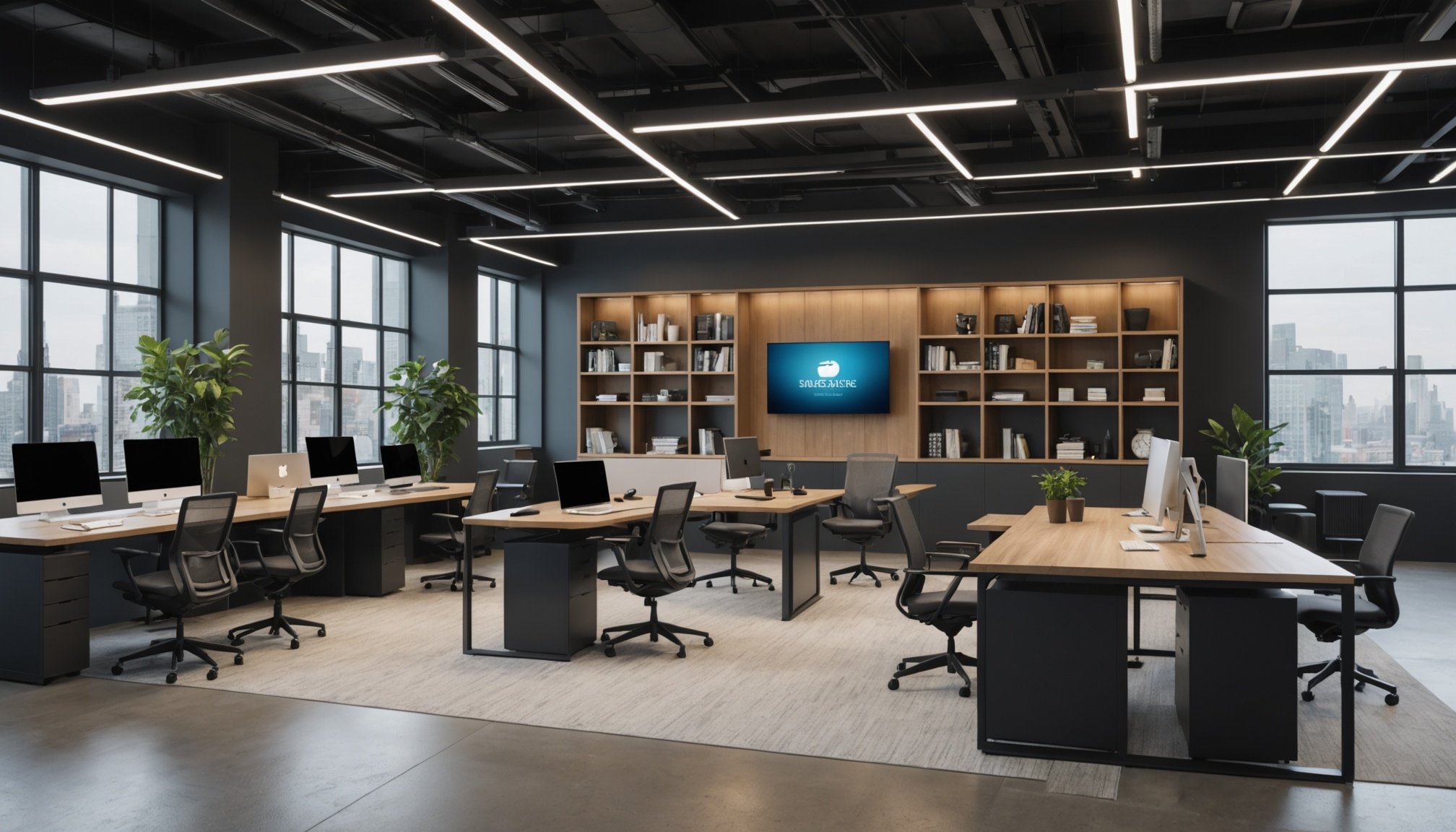Unveiling Cutting-Edge Workspace Design Trends Shaping the Future of Hybrid Work Environments
As we step into 2025, the landscape of workplace design is undergoing a significant transformation, driven by the rise of hybrid work models and the evolving needs of modern employees. Here’s a deep dive into the cutting-edge trends that are redefining the future of workspaces.
Embracing Task-Based Zoning and Adaptive Environments
In 2025, office design is all about creating spaces that are tailored to specific tasks and user needs. The concept of task-based zoning is gaining traction, where different areas of the office are designed for different types of work. This approach minimizes distractions and optimizes real estate by aligning the physical environment with cognitive needs[1].
Topic to read : Essential techniques for achieving superior indoor air quality in shopping malls
Benefits of Task-Based Zoning
- Reduced Distractions: By creating designated areas for specific functions, employees can focus better without the noise and interruptions associated with traditional open-plan offices.
- Increased Flexibility: Task-based zoning allows employees to move between different zones as needed, providing flexibility and balance in their workdays.
- Optimized Real Estate: This approach ensures that every square foot of the office is used efficiently, reducing waste and enhancing productivity.
For instance, quiet zones and tech-free areas are becoming essential for employees who need deep concentration, while collaborative zones are designed for team work and brainstorming sessions. Office pods, such as those offered by hushFree, provide enhanced privacy and sound isolation, making them ideal for both individual focus and group work[1].
Integrating Biophilic Design and Wellness-Centric Elements
Biophilic design, which involves incorporating natural elements into the workspace, is set to gain even more traction in 2025. This approach connects people with the natural world, fostering a sense of tranquility and calm that enhances concentration and overall well-being.
Also read : Maximizing benefits of green roofs: unlocking cost savings and eco-friendly gains for urban environments
Key Biophilic Design Elements
- Indoor Greenery: Living walls and plant life are becoming standard features in modern offices, providing a natural ambiance that boosts mood and productivity.
- Outdoor Spaces: Expansive windows, skylights, and balconies that offer views of nature and flood spaces with natural light are increasingly popular. These features are beneficial for both mood and circadian rhythms[3].
- Natural Materials: The use of natural materials in furniture and decor adds to the biophilic aesthetic, creating a more organic and welcoming work environment.
Wellness-centric elements are also a focus, with features like circadian lighting, acoustic systems to reduce distractions, and areas for movement such as yoga mats or standing desks. High-end air purifiers, aroma therapy diffusers, and soothing soundscapes further enhance the overall atmosphere, making the workspace a place where employees can feel both motivated and relaxed[5].
Leveraging Smart Technology and AI for Enhanced Productivity
Smart technology is revolutionizing office design in 2025, making workspaces more efficient, ergonomic, and sustainable. Here are some key trends:
Smart Office Accessories
- AI-Driven Desk Configurations: Desks that automatically adjust height, temperature, and even provide reminders for breaks are becoming essential for modern workspaces. These smart desks interact with employees, adapting to their preferred workstyles while monitoring well-being and energy usage[2][5].
- Advanced Cable Management: Premium accessories like magnetic ergonomic desk mats and durable monitor arms are vital for crafting organized and intuitive workspaces[4].
- Building Automation: Smart technologies allow for impressive energy conservation, aligning with sustainability goals. Building automation systems control lighting, temperature, and other environmental factors to create an optimal work environment[2].
Seamless Integration of Technology
- Voice-Activated Systems: These systems control everything from lighting to temperature, ensuring that the office always feels just right without needing manual adjustments.
- Immersive Tech: Virtual and augmented reality tools are gradually making their way into workspaces, making virtual meetings feel more like face-to-face interactions and allowing professionals to design and collaborate in 3D spaces[5].
Flexible and Multifunctional Spaces
Flexibility is a cornerstone of 2025 office design trends. Workspaces are evolving into dynamic hubs that cater to various work styles and activities.
Multifunctional Workspaces
- Convertible Furniture: Desk setups that can switch between standing and sitting positions are becoming common. Lounges can double as hot-desking areas, while meeting rooms can transform into boardroom setups, theatres, or classrooms[3][5].
- Outdoor Areas: Outdoor spaces are no longer just for fresh air; they can host events, workshops, and staff socials, making them invaluable extensions of the workplace[3].
Hot Desking and Shared Workstations
Hot desking focuses on flexibility, allowing employees to use different workstations as needed. Larger pods or booths serve as on-demand meeting spaces, ensuring employees have access to collaborative zones without the need for permanent meeting rooms. These modular designs fit into any hotdesking layout, offering flexibility without assigning spaces permanently[1].
Sustainable Office Design and Its Benefits
Sustainability is a critical aspect of 2025 office design trends, reflecting a broader commitment to environmental responsibility.
Benefits of Sustainable Office Design
- Employee Retention and Productivity: Sustainable office design fosters employee retention and enhances productivity through healthier environments. Incorporating sustainable materials and energy-efficient systems lowers operational costs and reduces carbon footprints[2].
- Corporate Responsibility: A sustainable approach reflects corporate responsibility, boosting brand reputation and ensuring compliance with evolving environmental standards and regulations.
- Wellness and Creativity: Sustainable design principles promote both productivity and relaxation, ensuring that the space supports the physical and mental needs of employees[5].
Office Acoustics and Noise Management
Office acoustics are taking center stage in 2025, as the soundscape increasingly influences employees’ mood and productivity.
Key Acoustic Design Elements
- Quiet Zones: Workspaces are being designed with quiet zones for focused tasks, minimizing distractions and enhancing concentration.
- Sound Transfer Management: Sound transfer is prioritized where it’s needed most, such as in meeting rooms, to ensure effective communication and collaboration[3].
Practical Insights and Actionable Advice
As businesses embark on redesigning their workspaces, here are some practical insights and actionable advice:
Assess Your Workforce Needs
- Understand the diverse needs of your employees, including their work styles, preferences, and any sensory sensitivities. This will help you design spaces that are inclusive and supportive.
Invest in Smart Technologies
- Implement AI-powered tools and smart office accessories to enhance productivity and efficiency. These technologies can adapt to the changing needs of your workforce.
Prioritize Sustainability
- Incorporate sustainable materials and energy-efficient systems into your office design. This not only reduces operational costs but also enhances employee well-being and corporate reputation.
Create Flexible and Multifunctional Spaces
- Design workspaces that can adapt to different activities and work styles. This includes using convertible furniture and creating multifunctional areas that can serve various purposes.
The future of hybrid work environments is about creating spaces that are adaptive, sustainable, and technologically advanced. By embracing task-based zoning, biophilic design, smart technology, and flexible workspaces, businesses can foster a work environment that supports the well-being and productivity of their employees.
As we move into 2025, it’s clear that the modern office is no longer just a physical space but an ecosystem that evolves with its inhabitants. By staying ahead of these trends, companies can ensure their workspaces are not just functional but also inspiring and supportive of their employees’ needs.
Detailed Bullet Point List: Key Trends in 2025 Office Design
-
Task-Based Zoning:
-
Designated areas for specific functions
-
Reduced distractions and optimized real estate
-
Flexibility and balance in workdays
-
Office pods for enhanced privacy and sound isolation
-
Biophilic Design:
-
Incorporation of natural elements
-
Indoor greenery and living walls
-
Outdoor spaces with natural views and light
-
Natural materials in furniture and decor
-
Smart Technology Integration:
-
AI-driven desk configurations
-
Advanced cable management
-
Building automation for energy conservation
-
Voice-activated systems
-
Immersive tech for virtual and augmented reality
-
Flexible and Multifunctional Spaces:
-
Convertible furniture
-
Hot desking and shared workstations
-
Multifunctional workspaces and outdoor areas
-
Modular designs for adaptability
-
Sustainable Office Design:
-
Sustainable materials and energy-efficient systems
-
Healthier environments for employee retention and productivity
-
Reduced operational costs and carbon footprints
-
Enhanced corporate responsibility and brand reputation
-
Office Acoustics and Noise Management:
-
Quiet zones for focused tasks
-
Sound transfer management in meeting rooms
-
Minimized distractions and enhanced concentration
Comprehensive Table: Comparing 2025 Office Design Trends
| Trend | Description | Benefits |
|---|---|---|
| Task-Based Zoning | Designated areas for specific functions | Reduced distractions, optimized real estate, flexibility and balance |
| Biophilic Design | Incorporation of natural elements | Enhanced well-being, concentration, and creativity |
| Smart Technology Integration | AI-driven desk configurations, advanced cable management, building automation | Enhanced productivity, efficiency, and sustainability |
| Flexible and Multifunctional Spaces | Convertible furniture, hot desking, multifunctional workspaces | Adaptability, reduced need for permanent meeting rooms |
| Sustainable Office Design | Sustainable materials, energy-efficient systems | Healthier environments, reduced operational costs, enhanced corporate responsibility |
| Office Acoustics and Noise Management | Quiet zones, sound transfer management | Minimized distractions, enhanced concentration |
Relevant Quotes
- “2025 workplaces put diversity first. Task-based zoning, quietude, and user-adapted environments are key.” – Hushoffice.com[1]
- “The modern office environment in 2025 will also champion personalized zones for each function and mood, from focus-driven nooks to buzzing, collaborative zones for brainstorming.” – Viking Blog[2]
- “Workspaces are being designed with noise management in mind, offering quiet zones for focused tasks and prioritizing sound transfer where it’s needed most, such as in meeting rooms.” – Workargyll.com[3]
- “Luxury home offices will integrate high-end air purifiers, aroma therapy diffusers, and soothing soundscapes to enhance the overall atmosphere.” – Luxury Home Office Design Trends 2025[5]
By embracing these trends, businesses can create work environments that are not only functional but also supportive of the well-being and productivity of their employees, setting the stage for a future where work, comfort, and health go hand in hand.

